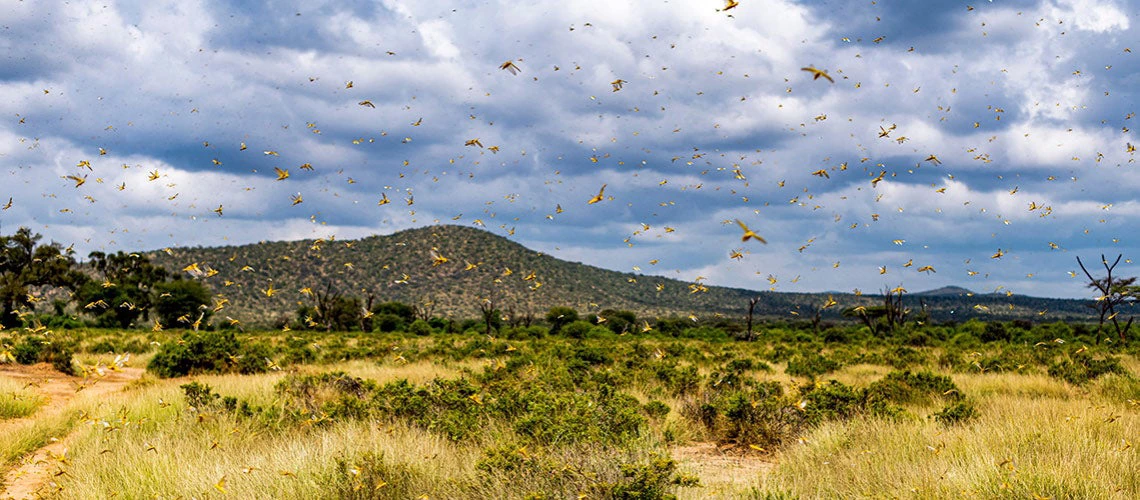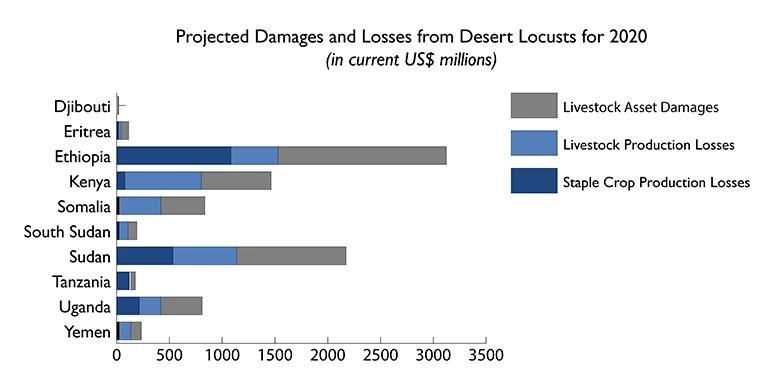 Des invasions de criquets menacent la sécurité alimentaire et les moyens de subsistance dans plusieurs régions du monde. © Jen Watson/Shutterstock
Des invasions de criquets menacent la sécurité alimentaire et les moyens de subsistance dans plusieurs régions du monde. © Jen Watson/Shutterstock
Every day, our inbox buzzes with alerts from an unfolding crisis. The reports—heralding a humanitarian crisis and giving voice to increasing desperation among those that we serve—are alarming. And with the COVID-19 pandemic, the situation is likely to worsen still.
A locust outbreak that’s the worst in a generation is spreading across Africa, the Middle East, North Africa and South Asia, caused by an outgoing El Nino and cyclones due to a changing climate. Locusts, which are the world’s most destructive migratory pest, can travel up to 90 miles a day, form 80 million-strong swarms and eat the same amount in vegetation as what large cities eat every day.
Locust swarms have infested 23 countries. East Africa is the epicenter of the locust crisis—with Ethiopia, Kenya, Somalia and Uganda among the affected countries. But the locusts have traveled far. They are also wiping out crops in Pakistan and damaging farms in Yemen, a fragile country already hit hard by years of conflict. The global locust crisis is forcing governments to fight on two fronts.
"The global locust crisis is forcing governments to fight on two fronts."
There’s the battle to contain COVID-19, which has already infected more than one million people, continues to overwhelm health services and severely impacts the global economy. And then there’s the fight to control the locust infestation that’s decimating millions of hectares of crops, leaving behind barren fields and devastated farmers with little left to harvest. In Djibouti, it is estimated that over 1,700 agropastoral farms across the country and nearly 50,000 hectares of pastureland have been destroyed by the swarms. Locusts have also torn through large swathes of the Horn of Africa, where more than 24 million people are food insecure and 12 million people are internally displaced.
In the time of COVID-19, the locust outbreak is a crisis within a crisis that’s putting the food security and livelihoods of millions of people at risk. This at a time when many countries are still recovering from recent shocks and traditional coping capacities across communities are already stretched beyond the breaking point. Africa seems set to fall into its first recession for 25 years due to the COVID-19 outbreak, which will further hobble the ability of governments to counter the crisis.
Just last week, swarms of newly-hatched locusts were reported in East Africa in a second, larger wave of infestation, an ominous threat that just happens to coincide with the region’s planting season. In Kenya, farmers have cropped maize, beans, sorghum, barley and millet in recent weeks hoping that a favorable rainy season will allow for abundant growth during late April and May. But with new swarms on the horizon gaining size and strength, experts fear that in Kenya and other areas up to 100% of farmers’ crops could affected.
"Without broad-scale control measures to control the locusts, damages and losses could reach US$8.5 billion by the end of 2020."
If countries don’t act now, the locust population will swell exponentially--they are projected to grow by up to 400 times their current numbers by June--and potentially spread to new areas, including West Africa, just as crops are ready to be harvested. Without broad-scale control measures to control the locusts, damages and losses could reach US$8.5 billion by the end of 2020.
Locust plagues can be difficult to control in normal circumstances, requiring cooperation across borders to destroy swarms before they multiply and equipment like airplanes that aren’t always readily available. The COVID-19 pandemic will make things even more challenging. Already, disrupted supply chains are delaying the delivery of locust control equipment and inhibiting access to critical materials and services. Lockdowns and travel restrictions are preventing response teams from reaching areas that desperately need their advice and expertise.
But even though affected countries are being stretched thin and challenged by the pandemic, it’s critical to act now to prevent further devastation and the threat of a multi-year famine. And the development community must stand with them to offer support.
The World Bank Group is moving to provide flexible support to countries affected by the outbreak.
In response to urgent need, the World Bank Group is moving to provide flexible support to countries affected by the outbreak. The Bank Group is coordinating closely with partners, including the UN-FAO, which is leading control efforts. To support the short-term response, the Bank Group is mobilizing emergency financing, combined with policy advice and technical assistance, to support countries in their immediate response to the infestation. In Kenya, US$ 13.7 million in emergency funding supports the Government in setting up six control bases across the affected counties for coordination of the control operations, deploying surveillance aircrafts, and providing ground control equipment and other materials needed for control. Dijbouti will also receive emergency funding.
To assist countries in the long-term, the Bank Group is finalizing a bigger package of support. The program’s goal is to help affected households and communities cope with the economic impacts of locust damage, restore their livelihoods and prevent future pest outbreaks. Even though the COVID-19 pandemic is putting some challenges in front of us, we’re working hard on delivering the package on an accelerated timeline, so that hard-hit farmers, pastoralists, and rural communities can get back on their feet sooner rather than later.




Join the Conversation